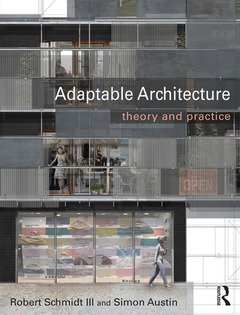Adaptable Architecture Theory and practice
Auteurs : Schmidt III Robert, Austin Simon

Adaptable Architecture provides thought-provoking and inquisitive insights into how we can prolong the useful life of buildings by designing them to be more adaptable, and hence create a more sustainable built environment. The book provides a theoretical foundation counterpointed by the experiences and ideas of those involved in the design and use of buildings. It explains many approaches to designing for change, with lessons from history, and case studies including The Cedar Rapids Public Library, Kentish Town Health Centre and Folkestone Performing Arts Centre, which stretch our thinking beyond the conventional notions of adaptability. The authors reveal the many conditions that make it a complex design phenomenon, by considering the purpose, design and business case of buildings as well as the physical product.
Full of summaries, diagrams, reference charts, tables, and photos of exemplar solutions for use as conversational tools or working aids, this book is for any professional or student who wants to research, question, imagine, illustrate - and ultimately design for - adaptation.
In addition, further information and resources are available through the Adaptable Futures website www.adaptablefutures.com which includes additional case studies, videos, information about industry events and up-to-the-minute developments.
Preface Adaptable Architecture Architecture is Unfinished Part 1: Introduction 1. Motivating Observations Part 2: A History of Adaptability 2. Historical Overview 3. Strands of Designing for Adaptability Part 3: A Theory for Adaptability 4. Developing the Concept 5. Common Takes on Adaptability 6. Buildings as Layers 7. A Typology of Adaptability 8. Design Strategies, Characteristics and Tactics 9. Building Characteristics in Detail 10. Unravelling Contextual Contingencies 11. Design Resources 12. Meta-models Part 4: Adaptability in Practice 13. Linking Theory to Case Studies 14. Primary Case Studies 15. Designing for Adaptability 16. Designing for Adaptable Futures Part 5: Conclusions 17. A Living Thing References
Robert Schmidt III is an architect and academic. He is Senior Lecturer in Architecture at Loughborough University, UK, a visiting researcher at Chongqing University, China, and the founder of Idapu, a design and research practice. His recent work has focused on urban transformation strategies, architectural education and practice models.
Simon Austin is Professor of Structural Engineering at Loughborough University, UK. His research interests include 3D printing, concrete materials and structures, building systems, workplace design and design management. He co-founded Adept Management, an international consultancy specializing in design and engineering management.
Date de parution : 07-2016
18.9x24.6 cm
Date de parution : 07-2016
18.9x24.6 cm
Thème d’Adaptable Architecture :
Mots-clés :
IBI Group; Adaptable Buildings; adaptable futures; A2 A3 A4 A5 A6; EPSRC; Smart Phones; life-cycle value; UK Housing Market; Space Plan Layers; movable architecture; Vice Versa; open buildings; Adaptable Architecture; adaptive buildings; IBI; adaptive reuse; Human Building Relationship; Quantity Surveyor; sustainable built environment; Eternal Laws; design; AT1; adaptation; Adaptability Types; adaptability; Design Tactics; The Cedar Rapids Public Library; Completion Date; Kentish Town Health Centre; Traditional Japanese Home; Folkestone Performing Arts Centre; Bathroom Pod; kinetic architecture; Function Analysis System Technique; White Cells; A1 A2 A3 A4 A5; Si Te; Sh Ad; Ti Ti; Pa Ce



